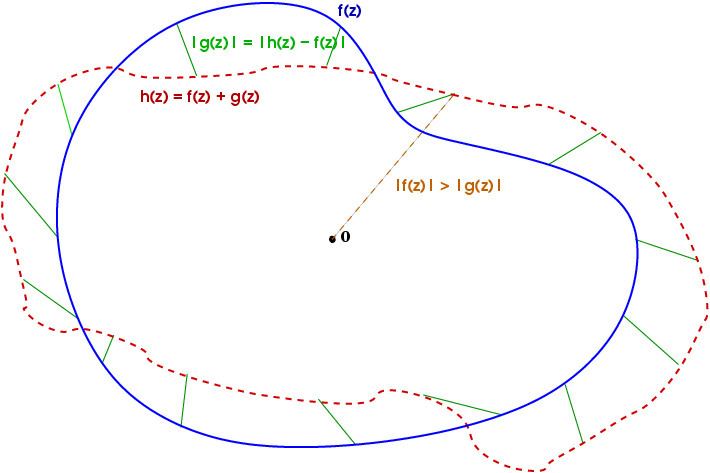 | ||
Rouché's theorem, named after Eugène Rouché, states that for any two complex-valued functions f and g holomorphic inside some region K with closed contour
Contents
Symmetric version
Theodor Estermann (1902–1991) proved in his book Complex Numbers and Functions the following statement: Let
holds on the boundary
The original Rouché's theorem then follows by setting
Usage
The theorem is usually used to simplify the problem of locating zeros, as follows. Given an analytic function, we write it as the sum of two parts, one of which is simpler and grows faster than (thus dominates) the other part. We can then locate the zeros by looking at only the dominating part. For example, the polynomial
Geometric explanation
It is possible to provide an informal explanation of Rouché's theorem.
Let C be a closed, simple curve (i.e., not self-intersecting). Let h(z) = f(z) + g(z). If f and g are both holomorphic on the interior of C, then h must also be holomorphic on the interior of C. Then, with the conditions imposed above, the Rouche's theorem in its original (and not symmetric) form says that
If |f(z)| > |h(z) − f(z)|, for every z in C, then f and h have the same number of zeros in the interior of C.Notice that the condition |f(z)| > |h(z) − f(z)| means that for any z, the distance from f(z) to the origin is larger than the length of h(z) − f(z), which in the following picture means that for each point on the blue curve, the segment joining it to the origin is larger than the green segment associated with it. Informally we can say that the blue curve f(z) is always closer to the red curve h(z) than it is to the origin.
The previous paragraph shows that h(z) must wind around the origin exactly as many times as f(z). The index of both curves around zero is therefore the same, so by the argument principle, f(z) and h(z) must have the same number of zeros inside C.
One popular, informal way to summarize this argument is as follows: If, say, Gérard de Nerval were to walk his lobster on a leash around and around a tree, such that the leash's length was always less than Nerval's distance to the tree, then the lobster would wind around the tree exactly as many times as Nerval.
Applications
Consider the polynomial
Rouché's theorem says that the polynomial has exactly one zero inside the disk
Rouché's theorem can also be used to give a short proof of the fundamental theorem of algebra. Let
and choose
Since
One advantage of this proof over the others is that it shows not only that a polynomial must have a zero but the number of its zeros is equal to its degree (counting, as usual, multiplicity).
Another use of Rouché's theorem is to prove the open mapping theorem for analytic functions. We refer to the article for the proof.
Proof of the symmetric form of Rouché's theorem
Let
i.e., the winding number of the closed curve
is a homotopy between the curves
is continuous and integer-valued, hence constant. This shows
